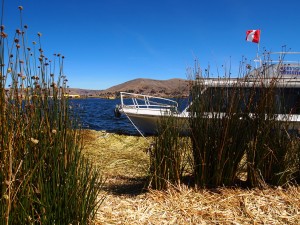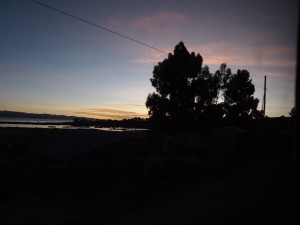After my conversation with both the receptionist at my hotel and the tourist office on the main square the night prior, I got the impression that Puno isn’t exactly a safe, happy tourist town the way Cusco is. It certainly isn’t beautiful or picturesque either, and I’m glad I only had 24 hours there, I definitely wasn’t upset upset to be leaving so soon. My floating islands tour was a bit frustrating — I was with a group of 5 Argentinians speaking in very loud, fast spanish, a Russian couple who shoved their way to the front of everything to get a ridiculous number of photos, and a Japanese woman who got on the boat and immediately took her socks and shoes off and began scratching her scab-covered feet. So bizarre.
 Our “tour” was supposed to be bilingual but it wasn’t much of a tour at all. Our guide didn’t speak a word the entire 30 minute boat ride to the islands, and once we got off onto one of the floating islands he explained a few things for less than 10 minutes, almost entirely in Spanish. When I got frustrated and tried to tell him I couldn’t understand the Spanish explanations, he said “Oh, sorry” and then continued speaking in Spanish. And on top of that, the Argentine girls kept yelling and shouting things over everyone else, asking questions and getting answers that I also couldn’t understand. Regardless of the weird group, the floating islands and our boat ride were really interesting, and I’m glad I got to see them, even if I didn’t really enjoy them. It was a strange reality to observe these families living on individual islands, meant just for them and their close family members. It was hard in many ways to tell what was authentic about their lifestyle and what was a sort of show for the hundreds of tourists that come to their island each month.
Our “tour” was supposed to be bilingual but it wasn’t much of a tour at all. Our guide didn’t speak a word the entire 30 minute boat ride to the islands, and once we got off onto one of the floating islands he explained a few things for less than 10 minutes, almost entirely in Spanish. When I got frustrated and tried to tell him I couldn’t understand the Spanish explanations, he said “Oh, sorry” and then continued speaking in Spanish. And on top of that, the Argentine girls kept yelling and shouting things over everyone else, asking questions and getting answers that I also couldn’t understand. Regardless of the weird group, the floating islands and our boat ride were really interesting, and I’m glad I got to see them, even if I didn’t really enjoy them. It was a strange reality to observe these families living on individual islands, meant just for them and their close family members. It was hard in many ways to tell what was authentic about their lifestyle and what was a sort of show for the hundreds of tourists that come to their island each month.
I will admit it was a very unique experience to be standing on an island made entirely of reeds, suspended above an enormous lake. Lake Titicaca from the Peruvian side is beautiful in its expansiveness, and very calm, in comparison to Bolivia’s side. If I were to do it again, I’d probably skip Puno entirely and spend more time in Copacabana instead, but I’m glad I had the chance to do them both, and I know for next time!
One of the family members of the island we visited spoke relatively good English, so he took me inside his home and showed me around. He explained that he goes to Puno once a week to get groceries and anything else the family needs, but that high school children go to the city every day. Elementary school children are educated in the island community on the “main island,” another floating island just a few minutes away by boat. Once we paid an additional 5 soles, the family took us on an extra boat ride around the islands on their personal boat. Though I was happy to give them the $2, I felt sort of obliged to go on the boat ride. I also felt a lot of pressure to buy the unimpressive souvenirs they were selling. Saying “no, gracias” just didn’t seem good enough, and it was frustrating that I’d pay to go on a tour to feel pressured to spend more money. The whole experience felt very touristy and very routine, which I didn’t enjoy.
When I got back to Puno after the tour I had an hour or so at the hotel before I had to be at the bus station, so I asked the guy at my hostel for a good local restaurant recommendation. His answer? He couldn’t suggest anything good in the area aside from the restaurant I’d already eaten at last night. Not so impressive, and also made me glad I was leaving! I ended up walking down to the main square and getting a cheap chicken sandwich at a local heladeria. Not great, but for 4 soles, it did the trick!
A few minutes after I got back to the hotel from lunch, a woman rushed into the lobby, calling my name frantically. For some reason I still can’t figure out, she had my bus ticket for the bus to Bolivia I was getting on in an hour and a half in her hand. I was under the impression I needed to pick up the ticket with my passport at the actual bus station, which is why I was planning to get there an hour early, and was super confused as to who she was and what was going on. I kept trying to ask questions, but she and the hotel clerk spoke to each other in Spanish and didn’t really explain anything to me, all I know is that she somehow was connected to GTB, and she had my name on the bus ticket, spelled “Racel Cusman.”
In the end she just handed me my ticket, called me a cab, and warned as it pulled away that I shouldn’t pay more than 4 soles for the ride. When I finally got to the bus station, I had to ask 3 people questions before I figured out I needed to pay a 1 soles tax on my ticket out of the city. Sweaty and frustrated, I finally found my bus.
The guys in charge made sure I had all my paper work, a photocopy of my passport, a photo for my visa, and my paperwork from entering Peru. Their diligence in checking my paperwork made me feel a bit reassured, but not much. I was very anxious for the entire 2 1/2 hour bus ride — crossing the border to Bolivia was something I had read a ton about and was the most nervous for during the entire 10 days of my time alone. I had heard such crazy things, including my friend Sarah getting left at the visa office, of people being scammed, etc. As we were driving, I kept thinking we were finally at the border but it turned out we weren’t even close.
The actual border crossing wasn’t as horrific as I had imagined, but it was quite bizarre. When the bus pulled up, the driver made the 3 Americans get off first, in anticipation of us taking the longest. First, I had to get my passport stamped out on the Peruvian side twice, in two separate offices, one right next to the other. Then I had to walk up the hill to Bolivia and into the visa office, a tiny whole-in-the-wall building that looked far from official. There, I had fill out a visa application form. Once I handed the officer my application, all of my customs forms, the copy of my passport and my passport photo, I then had to watch him deeply inspect my $20 bills (Americans have to pay $135 as an entrance/visa fee) for any possible tiny rip or flaw. He could have cared less what was actually written on my forms, what I was doing in the country, where I was going or who I was, but because one of my $20’s had a slight line at the top, middle part of the bill where it had been folded, he simply crossed his arms and said he wouldn’t accept it. Luckily, another guy in line from my bus, also from California, had extra $20’s on him, so he was willing to trade one of his bills with me. Not sure what I would have done otherwise — seriously ridiculous!
After the officer finally accepted my money, he put a visa sticker in my passport saying my entrance fee gave me until 2017 to come back to visit the country, then sent me across the room to another border control officer who took my immigration paperwork, very slowly stamped my forms and my passport, then wrote a “90” next to my stamp, which apparently means I can be in the country for 90 days on this visit.
My heart racing, I left the building and was more than relieved to see my bus was sitting outside, my luggage intact. It was a very short drive from the border into Copacabana, but I got to see an absolutely beautiful sunset over the lake, which was very calming!
When I got off the bus in town and tried to ask a handful of people if they could help me get a taxi, no one would help or even give me a map. Finally, one guy told me I couldn’t get a taxi, that my hotel was just 2 blocks “up” and that I had to walk. So with my purse, backpack and very heavy duffel bag, I shlepped myself up the relatively steep hill, thankful to see signs with my hotel name, pointing me in the right direction. Even though I’ve been up in Cusco since Saturday evening, the altitude in Copacabana immediately started getting to me — I had a major headache from sitting on the bus, and I was huffing and puffing by the time I got the three blocks, uphill, to Hotel Cupula. So much for being in shape after my trek!
After I checked in I spent an hour or so in the TV room, watching Rain Man with a couple from Sweden (I’m telling you, there are SO many couples traveling around South America — who knew?!) and reading about Isla de Sol and Copacabana online. I had a quinoa salad for dinner at the hotel restaurant that would have been good had it not been absolutely drenched in balsamic vinegar. It was wonderful to have a private room at my hotel, even though I was paying $20 a night instead of the $10 average at most hostels in the city, I was in desperate need of a room to myself — well worth the extra $20 splurge!

